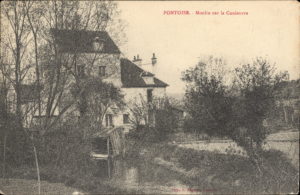R483 – Le Moulin sur la Couleuvre à Pontoise 1881 (FWN158)
Pavel Machotka
(Cliquer sur l’image pour l’agrandir)
From the late 1870s to 1880 Cézanne developed, by degrees which cannot always be described clearly, the method of laying his touches down parallel to each other. It was a discovery of incalculable importance to him, and he used it in most of his paintings for about five years – flexibly, in relation above all to his subject.[1] In about 1881, when he was again in Pissarro’s company, he momentarily explored the use of another touch. In Le Moulin sur la Couleuvre à Pontoise (Fig. 21a) and several related landscapes he used a curved touch; the result was decorative, soft, fleecy. The touch rippled across the canvas, suggested the texture of vegetation, and contrasted sharply with the simple, solid structures. And in Moulin it sets the buildings perfectly convincingly in their surroundings.
If one looks only at black and white reproductions of Cézanne’s paintings, one can see why he can be misunderstood as having organized his vision primarily in geometric patterns. But if one sees them in color, and particularly if one compares them with color photographs of the motif, one is struck by his sensitivity to local color and ambient light, and his precision in handling them. The cool light of the Ile de France is very distinct from that of Aix-en-Provence, and is scrupulously observed here without any trace of his earlier interest in atmospheric effects.
Adapted from Pavel Machotka, Cézanne: Landscape into art.
[1] See Theodore Reff, “Cézanne’s constructive stroke,” 1962, and my Cézanne: The Eye and the Mind, chapter 3, for more detailed accounts of its development, and the discussions that follow in the present chapter for examples of its power to organize the surface of a painting.





